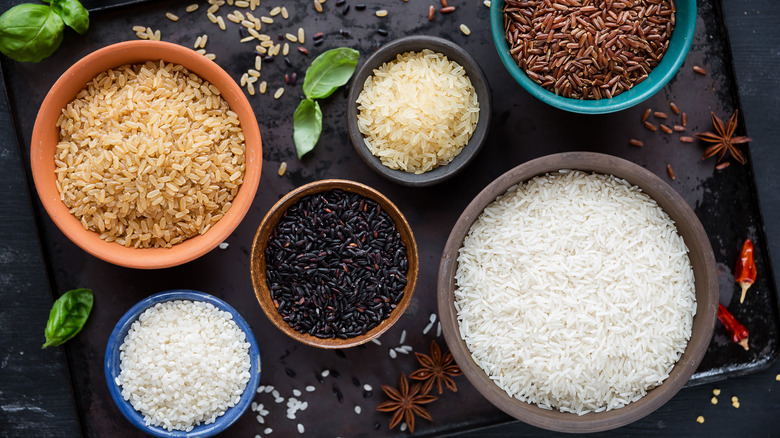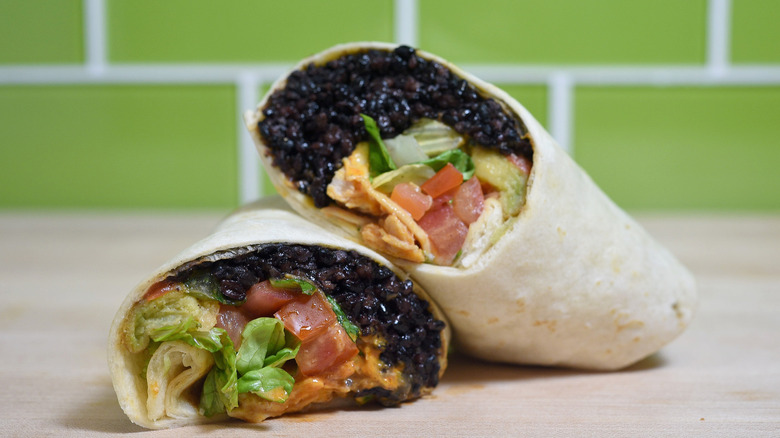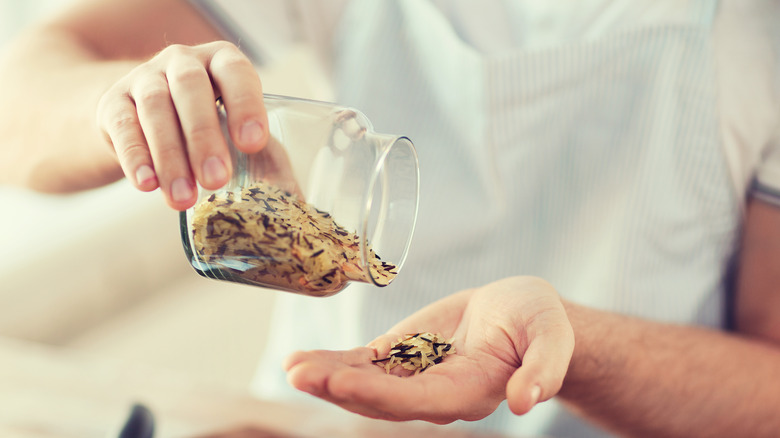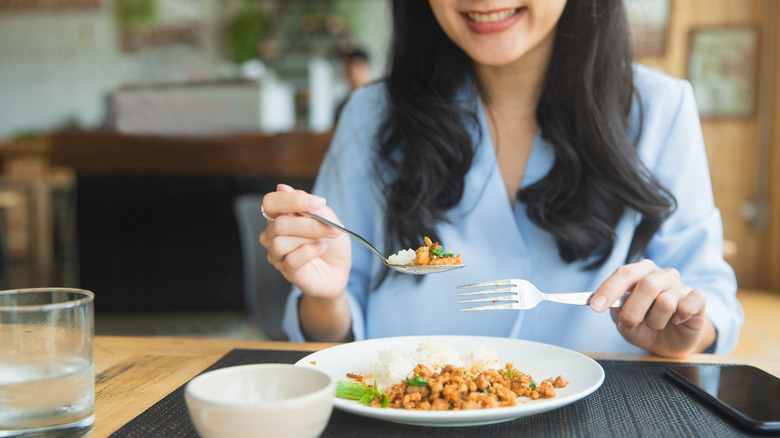Types Of Rice You Should Always Keep Stocked In The Pantry
Looking for the healthiest types of rice? One option is brown rice, which packs more fiber and minerals than its refined counterpart. A 3.5-ounce serving of cooked brown rice provides 112 calories, 2.3 grams of protein, and 23.5 grams of carbs, including 1.8 grams of fiber, reports My Food Data. Cooked white rice, by comparison, boasts 130 calories, 2.7 grams of protein, and 28 grams of carbs, including 0.4 grams of fiber, per 3.5 ounces. Brown rice, however, is significantly higher in magnesium, potassium, phosphorus, manganese, and heart-healthy fats.
Generally, white rice is the least nutritious option because it has the bran and germ removed during processing. Therefore, it's lower in fiber, B-complex vitamins, and other nutrients compared to whole rice, said dietician Lauren Harris-Pincus in an interview with Women's Health. Brown rice, on the other hand, contains all three parts of the kernel. This means it's higher in fiber and other beneficial compounds, as well as "more filling and satisfying" than its white counterpart, explains Harris-Pincus.
Some types of rice are even healthier, notes dietitian Marisa Moore (via Women's Health). Plus, you can use them in a multitude of recipes without compromising on flavor.
Black rice is loaded with anthocyanins
With its rich color and nutty taste, black rice will turn your meals into a feast. Centuries ago, this superfood was reserved for the wealthy, but nowadays it's widely available in grocery stores. Also known as the forbidden rice, it offers large doses of vitamin E, iron, calcium, potassium, zinc, and antioxidants. WebMD notes that black rice is particularly high in anthocyanins, a class of antioxidants that fight inflammation and support heart health. A half-cup of cooked black rice supplies 173 calories, 5 grams of protein, 2 grams of fat, and 38 grams of carbs, including 3 grams of fiber.
Lutein and zeaxanthin, two antioxidants in black rice, promote eye health and may counteract the harmful effects of ultraviolet radiation, says WebMD. Anthocyanins and other phytonutrients improve insulin response, helping your body use sugar more efficiently. These nutrients may also protect against cancer, obesity, and osteoporosis, according to clinical research published in the journal Antioxidants. In clinical trials, anthocyanins have been shown to inhibit breast tumor growth and metastasis, boost immune function, and reduce blood sugar.
Just like white rice, this grain can be steamed, boiled, or prepared in a pressure cooker. It goes well with mushrooms, vegetables, chicken, honey, fruits, and meat. WebMD suggests rinsing the dry rice before you cook it to reduce its arsenic content. After that, you can use it in both sweet and savory dishes, from soups and salads to rice pudding.
Stock up on wild rice to cut calories and carbs
Make sure you also stock up your pantry with wild rice, a whole grain that promotes cardiovascular health and fights oxidative stress (via Nutrition Reviews). On top of that, it has fewer calories and carbs than other rice varieties. WebMD reports that wild rice boasts 101 calories, 4 grams of protein, 23 grams of carbs — including 1.8 grams of fiber, and less than 1 gram of fat per 3.5 ounces. It's also an excellent source of alpha-lipoic acid (ALA), zinc, copper, magnesium, manganese, and B-complex vitamins.
Manganese, one of the most abundant minerals in wild rice, helps your body metabolize carbs, glucose, cholesterol, and amino acids. Moreover, it plays a key role in bone health, immune function, and blood clotting, states the National Institutes of Health. A diet low in this nutrient can affect your mood, increase menstrual pain, and reduce bone density. ALA, another essential nutrient, supports insulin production and may benefit those with diabetes-related nerve damage, explains WebMD.
Note that wild rice takes longer to cook than white rice, but you can soak it overnight to cut the cooking time in half, notes WebMD. Next, you can use it in any recipe that would otherwise require white, brown, or black rice. It's an excellent choice for soups, casseroles, pilafs, puddings, salads, side dishes, and even sushi.
Sprouted brown rice keeps your brain sharp
Last but not least, fill your pantry with brown rice and then let it sprout in a jar. Germinated (sprouted) brown rice has 964% more vitamin E and 120% more fiber than plain white rice, notes the Whole Grains Council. It's also much higher in magnesium, antioxidants, and vitamin E than its refined counterpart. Research indicates that it may help reduce high blood pressure and cholesterol levels while protecting against chronic diseases (per Critical Reviews in Food Science and Nutrition).
What's more, sprouted brown rice boasts large doses of gamma-aminobutyric acid (GABA), a compound linked to better sleep, reduced anxiety, and improved heart health. Its GABA content is four times higher than that of brown rice and 10 times higher than that of white rice, reports the Whole Grains Council. GABA is a naturally occurring neurotransmitter that protects your brain, reduces stress levels, and improves cognition, explains Medical News Today.
"This germinating process breaks down some of the starch, which makes the percentage of nutrients higher. It also breaks down phytate, a form of phytic acid that normally decreases absorption of vitamins and minerals in the body," registered dietitian Kristina Secinaro told Harvard Medical School. She also says that sprouted grains are easier to digest due to their low starch content. To stay on the safe side, cook the raw sprouts before consumption and refrigerate the leftovers. Cooking should destroy any bacteria that may have formed during germination, says Dr. Secinaro.



